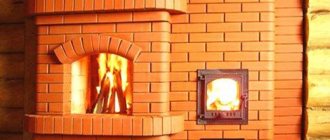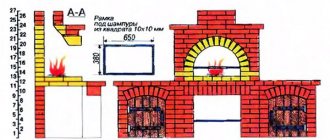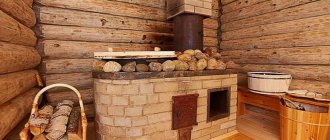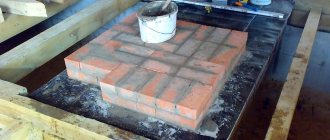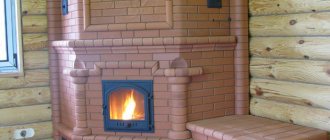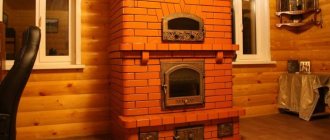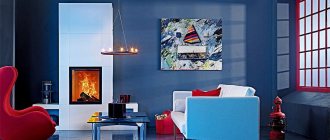In modern homes, fireplaces not only perform their main function, but are also a decorative element. The most widespread are various brick structures.
With proper placement, selection of the model, preparation of the solution and other important components, it can not only decorate the interior, but also heat the room.
During construction, property owners are primarily concerned with issues related to safety, ease of use and lack of smoke.
Advantages
Modern technologies keep pace with people's needs. It is for this reason that the long-known brick stoves have been replaced by new fireplace stoves. This design is a monoblock with a pipe channel and is installed on a single base. Moreover, each element has its own special meaning.
Conventional stoves have no decorative value, but you can cook with them. Fireplaces can please the eye and heat the room. But the fireplace-stove combines the functionality of both devices with an interesting design. It's like a fireplace with a stove - very convenient and functional. The main advantages of a brick stove-fireplace:
- The structure can warm up the air in the room quite quickly.
- The stove and fireplace can be used separately from each other. You can only cook or only heat the room - as you wish.
- Efficiency is about 80%.
- Ash pans with holes under each firebox make the cleaning process very simple and quick.
- When manufactured with high quality, a brick fireplace stove will serve for decades.
The structure can be installed in such a way that the stove will be localized in the kitchen space, and the fireplace in the living room. If a real master gets down to business, the fireplace stove turns into a real work of art and will decorate your home for many years. A brick fireplace stove would be a good choice for a country house. This will save on heating and electrical costs in general. This design can also be used as needed.
Finishing
If the kitchen combined with the living room has the same floor covering, then there are no special rules for carrying out the work. When combining different materials, take into account in advance where they will be joined.
For example, laminate flooring creates unsightly joints with tiles. The main thing is that the floor is flat without curved joints, as they will be noticeable. Kitchen cabinets that are mounted on the walls should reach the ceilings. In some cases, craftsmen “lower” the ceiling with plasterboard.
Options
There are quite a few variations of brick units. They differ in complexity and functionality. The most common types are: Swedish, Finnish, Russian and Dutch. There are also modified versions of stoves that are named after their creators.
There are ovens that do not have a hob at all. They represent a rudimentary wall structure with smoke exhaust channels, fireboxes, cleaning and blower chambers located between them. Such units are used for heating. Another option is a fireplace-stove with a heating and hob surface. Such stoves attract people with their versatility. They are more complex to design and install. Let's consider several interesting types of brick fireplaces and stoves:
With open firebox
Fireplaces with an open firebox allow you to warm up the air in the room in a fairly short time. If this design includes a hob, cooking is very easy. Owners of such fireplace-stoves can install barbecues right in the house and barbecue at any time of the year.
With air heating
Air-heated fireplaces are considered the best for heating a home. In such designs, a cast iron firebox is used. The duct system extends throughout the house and the casing in combination gives the desired result - complete heating. The system works in such a way that cold air is directed directly into the firebox, heats up and rises up through the pipes.
With water heating
Fireplaces with water circuits are gaining popularity. This design may include a heating and hob panel. A stove connected to heating has a great advantage over its counterparts - it pleases the eye, warms the whole house, and makes it possible to cook. Such designs are often used for baths.
As already mentioned, there are modification options. But knowing the basic models, you can easily choose the format that is convenient for you.
Size calculation
Like any heating device, size affects its thermal performance.
Therefore, before designing it, it is necessary to determine its exact dimensions. For these purposes, a proportion of 1:50 – 1:70 is used. The volume of the room itself and the combustion opening is taken as a ratio. As for the depth of the firebox, it should correspond to the height in a ratio of 1:2 - 2:3. It should be taken into account that the back wall is made approximately 12 cm thick, and the side walls - 25 cm. By calculating these values, you can get the exact size of the future fireplace and optimally place it in the chosen location. Based on the size of the firebox, the chimney is also calculated, which should be 8-15 times smaller in diameter. Calculation of the dimensions of a brick fireplace
| Fireplace elements | S-12m² | S-15m² | S-20m² | S-25m² | S-30m² | S-35m² |
| Portal width | 50 | 60 | 70 | 80 | 90 | 100 |
| Portal height | 42 | 49 | 56 | 63 | 70 | 77 |
| Firebox depth | 30 | 32 | 35 | 38 | 40 | 42 |
| Height of the rear wall of the firebox | 36 | 36 | 36 | 36 | 36 | 36 |
| Firebox rear wall width | 30 | 40 | 45 | 50 | 60 | 70 |
| Smoke collector height | 57 | 60 | 63 | 66 | 70 | 80 |
| Section of a brick chimney | 14x27 | 14x27 | 27x27 | 27x27 | 27x40 | 27x40 |
| Cross section of a metal chimney | 200 | 200 | 230 | 250 | 300 | 300 |
Stylistics
A well-chosen fireplace should be combined with the overall style of your interior. Only then will such an addition look beautiful. Fireplace stoves are often made independently or to order. The Finnish model is quite popular. Let's look at the most popular styles in which this unit is made:
Minimalism
Minimalism is characterized by strict forms and lines. In houses of this style, small fireplaces are installed, which serve a decorative and heating role. A laconic design with a minimum number of decorative parts is the perfect set. Any room in your home will become even more cozy when it has a mini fireplace.
A small fireplace stove will fit well into a minimalist interior and will delight you and your guests. In addition, this option is well suited for houses with a small area. Here you can also install a structure in which the stove will face the kitchen, and the fireplace itself will face the living room.
Classic
Fireplaces of this style were the first. They were installed by noble people as an interesting piece of furniture and a sign of their superiority. Such fireplace stoves always have the correct shape and only expensive finishing or carving.
Such units usually go flush with the wall. This arrangement determines the main decorative accent on the firebox itself. All designs of such furnaces include a U-shaped portal. But you can also choose a non-embedded option. In this case, the fireplace stove is located against the wall, and the chimney is covered with a stylized casing.
Modern
This type of fireplace stove is often chosen by young people. You can buy a lot of interesting options. Such units are often used as architectural details. These fireplaces are often installed so that they blend into the wall and resemble a window with a fire. An interesting option is when a double-sided fireplace stove is installed in the interior wall. With this arrangement, you can use the structure as a piece of furniture on one side, and on the other as a stove.
Rustic
These are country style fireplaces. This design will look good in a wooden house. Natural wood ceilings, harmoniously selected wall finishes and dark floors. Moreover, using wallpaper in this case is completely impractical. They will quickly become unusable due to the stove. A Russian stove works well. Carved decorative elements will add originality and exclusivity.
Venetian
Fireplace stoves of this style are quite massive and clearly stand out against the background of the wall. They are designed to show everyone around their power and sophistication in one person. In an interior of the appropriate style, such fireplaces look like a charming integral attribute.
Partitions
The interior of the kitchen and living room begins to be thought out from the junction of the two zones.
- Here are some of the ways and objects that delimit space:
- installation of a bar counter;
- kitchen island;
- big table;
- installation of a low partition.
Designers advise installing a wide counter, since you can sit at it like at a regular table, and high chairs are quite suitable for the whole family.
However, in small rooms (16 sq m), narrow counters are installed. Kitchen islands are convenient to use, but are only suitable for large kitchen-dining rooms (25 sq m or 30 sq m). Capital low partitions are installed only if it has been decided in advance what they will be used for (for example, as a TV stand).
Principle of operation
Any stove has three main components: firebox, pipe, chimney. The main part is the firebox. This is where the wood burns. There is a hole at the bottom. Through it, air enters the firebox, which is necessary for combustion. This hole is covered with a special grill, so the firewood does not fall out. Air gets inside the firebox, and ash and other combustion products fall from the firebox into the hole.
There is a special door that allows you to put firewood into the firebox. And the firebox itself is closed on all sides. Just above the firebox is the hob. It is heated by fire and allows you to cook food. Oven ovens work the same way.
The ash pan chamber is located under the firebox. It also has a door to allow the chamber to be cleaned. The door is also able to regulate the amount of air that enters the firebox. In the arch of the firebox there is another hole - hailo. It is through it that hot air comes out, which heats the oven.
The pipes are designed to remove combustion products from the furnace. There are two types:
- Mounted. Installed on the stove.
- Indigenous. They may have their own foundation or be located inside a wall.
The most important feature that distinguishes a stove from a fireplace is that in the second option you can freely observe the fire. To prevent heat from escaping into the pipe, a heat shield is installed. In the combined version, the stove-fireplace has all the advantages of a stove and allows you to observe the flame.
Zoning
Designers do not advise giving in to fashion trends and copying design ideas without taking into account dimensions, location and other nuances. Before planning and arranging furniture, every detail is thought through. There are several simple rules that experts advise you to follow:
- Let the room have natural light. To do this, remove excess walls (except for load-bearing ones).
- If the rooms in the apartment are small (12 sq. m or 16 sq. m), the layout of the kitchen combined with the dining room will be the right solution.
- If the ventilation system is not designed correctly, the smell of food will spread throughout the apartment.
Materials
The variety of available materials for making brick fireplaces and stoves is quite limited, but it allows you to create unique products. The units can be constructed from both ordinary bricks and figured bricks. When choosing a brick, its strength grade plays a big role.
Fireclay bricks (less commonly, quartz bricks) are used quite often because they are not sensitive to high temperatures. They lay out the area near the firebox. Heat resistant material is a must. Figured brick is relevant if you do not plan to decorate the fireplace stove. If any decorative work is planned, the external data of the masonry itself does not matter.
Clinker brick is one of the varieties of quartz. But in its production, slightly modified technologies are used. It is not used so often for two reasons: the material is quite expensive and heavy. But if your stove is large, then such a brick is perfect for building a foundation.
In order for the appearance of the structure to please the eye, you need to be guided by certain requirements when laying out the facing layer. The brick should be fairly solid and have good heat transfer. Paint will help create a unique look for your fireplace stove.
Color combinations
Stylists advise taking into account the following nuances:
- direction in the interior;
- combination of shades;
- illumination
It is much easier to choose a palette if the style for the kitchen and living room has already been selected. For example, neoclassicism and Provence have their own combinations. In a classic interior, designers combine pastel colors, pale colors, which are slightly diluted with dark shades. In French country houses you can often see soft blue, pink, and pistachio colors. Art Deco designers make up objects and finishing materials in black and white, sometimes beige and brown or silver and black. The main thing is to choose a shade for the walls. White will become universal, it will expand the space, and later you can paint them with any paint. However, in the cooking area, white ceases to look fresh. Beige or gray shades would be more practical. This background will highlight the other colors. In a monochrome interior, designers recommend gluing wallpaper in an unusual color or with a photo print.
Waterproof surfaces are easy to clean, so washable wallpaper is recommended. The colors of the furniture echo the details and accessories, be it cushions for the sofa, curtains or other items.
- Cast iron fireplace
- Fireplace with water heating
- Corner fireplace
Tools and accessories
Making a fireplace stove requires certain accessories. The most necessary:
- Kiln brick.
- Heat-resistant clay mixture.
- Door with heat-resistant glass.
- Cast iron firebox door.
- Iron door for chimney and ash pan.
- Furnace grates.
- Surface for cooking. A cast iron stove should have the number of burners you need.
- Corners and corner shelf. As a rule, they are made of steel.
- Steel sheet up to 3 mm. Asbestos or basalt sheets for thermal insulation.
- Pipe and parts for connecting the chimney opening.
- Rolls and boards of waterproofing.
- Mixtures of concrete and soil.
- Bags of crushed stone and sand.
- Ceramic granite or tiles.
You need to choose materials very carefully. The strength and durability of the fireplace stove depends on their quality.
Provence
The name of this destination comes from a region in the south of France. Even a small kitchen-living room, the decor of which was inspired by French aesthetics, will be filled with warmth and comfort.
The main thing is that it has a lot of daylight, textiles with romantic prints, and floral patterns. The dining room in the Provence style is designed in pastel shades. Furniture items can be vintage or artificially aged. Plain walls will contrast with large checkered curtains. The door in the kitchen area set is sometimes replaced with curtains made from the same material as the tablecloth. A good addition would be vases and figurines, clay pots, forged metal parts and ribbons.
Masonry technology
Before you line the fireplace-stove with bricks, you need to draw up a diagram. It reflects all the necessary elements in the right places. Construction takes place in several stages:
- Base. We dig a pit and fill the bottom with crushed stone. The formwork is constructed using planed boards, and the pit itself is filled with cement.
- After 3-5 days the work continues. The brickwork is covered with roofing felt. Now the bottom row of bricks is laid out.
- Next, drawings play a big role. In agreement with them, the remaining bricks are laid out and the casting is installed. In order for the brick to have better contact with the mixture, it is soaked in water. The order is of great importance. Stick to it and you won’t have to redo the work. The inner sides of the furnace are smoothed during the process so that combustion products do not subsequently settle there.
- Now the chimney. It is important to remember fire safety measures here.
- The fireplace stove should dry naturally. This takes literally a few weeks.
- During the period of active drying, the oven is heated. Do this until all seams are the same color.
Scandinavian
This style came into fashion several years ago, but still does not lose its relevance. Its practicality and European elegance are well suited for a living room in a city apartment or house. You can add bright accents, for example, textiles of different shades.
The basis for the Scandinavian style is white and gray finishing, wooden details. To decorate the space, pink, blue or ocher elements are suitable.
Types of chimneys
The chimney acts as a channel system and is located inside the brickwork. The dimensions of the chimney directly depend on the dimensions of the fireplace stove. There are several types of chimneys:
- The simplest chimneys consist of certain sections that combine direct and return air flow. This design ends with a pipe. Return current areas are constructed from parallel channels. This is done in order to increase efficiency and improve air heating.
- Multi-turn chimneys. They differ from the previous ones only in the number of alternations of sections. The walls are heated more evenly because of this.
- Chimney without ducts. In such designs, everything is focused on the camera. Gases from the heil tend to the roof of the chamber, where they cool and descend back. The vapors give off their heat to the walls of the hood chamber. Exhaust gases exit into the pipe through openings at the bottom and side.
Any type can be used. It all depends on your needs.
Neoclassical
Even popular music has echoes of ancient motifs. The same can be said about the design, in which classic details are framed in a fashionable design.
This style is characterized by symmetrical lines, framed mirrors, arched openings, and antique accents. All this is complemented by fashionable finishing materials and accessories. Neoclassicism combines sleek modern details with traditional combinations.
Tips for use
Experienced stove makers can give useful advice on both the construction process and the operation of the fireplace stove. Do not use coniferous firewood, otherwise the chimney will become dirty and stop functioning. Firewood should always be well dried, this is important for long burning. Under no circumstances burn household waste and various types of waste paper - toxins will be released into the air.
A sauna stove must meet many criteria. Reviews show that it is better to pay attention to Finnish manufacturers. Every part of their product comes with a warranty, making repairs easy. A fireplace screen should be quite reliable.
When constructing with your own hands, always use the diagrams. They will help you understand exactly how the components should be placed in each line. Be sure to use a building level during this process. Corner and front structures are the most popular. But this depends on the overall layout of the house.
Similar articles
- Stove and fireplace: types, design, how to fold it with your own hands and make a pipe Preface The modern design of a heating stove allows, with minimal energy costs, to ensure a stable supply of thermal energy to…
- Do-it-yourself sauna stove - how to make it
Before starting work on building a sauna stove, you should decide on the type that is best suited for your specific conditions…. - Construction of a brick fence from stone, brick, polycarbonate, slate.
Photo, price A fence constructed from brick is rightfully considered elite. The design requires considerable investment. The complexity of the work is complemented by...
Multi-level floor
To zone the space, craftsmen install floors at different levels. They advise installing a podium to separate the kitchen and dining room. This option is considered one of the most practical because, among other things, the owners have additional free space where they can hide something. It is convenient to use boxes or crates for this. Wicker baskets will look good. But such space can remain free.
For podiums, reliable materials are selected that can withstand heavy loads. Usually builders make wooden or metal podiums.
However, such a design should not be made if there are small children in the family, since the podium can become an obstacle for him. In addition, various floor coverings can be used. They will zone the space between the living room and the kitchen and protect the podium from damage. For example, tiles are laid in the kitchen area, and laminate flooring in the dining room. The main thing is to choose colors and textures and combine the finishes correctly.
Advantages of a decorative hearth
The only difference between an electric fireplace and a real one is the absence of a chimney. Otherwise, the design repeats all the external features of a wood-burning fireplace. There is a fireplace in the building, and the portal itself is closed by a natural mantelpiece. The size of the fuel chamber varies greatly. In the case of a decorative fireplace, its depth does not exceed 20 cm. Additional volume is created by glued internal mirrors.
The imitation was invented for urban homes, where the installation of a real fireplace is prohibited due to safety concerns. Mainly because it is impossible to make a decent chimney. Well, maybe on the upper floors. But there, as elsewhere, the law prohibits lighting open fires.
Since there is usually no need for additional heating of the room, only aesthetic elements can be used. This type of decor can decorate rooms in any style. With a decorative fireplace in the living room, the living room benefits in many ways.
Among the advantages of a false hearth are the following:
- You don't need a lot of money to create decor. Except when you need to create a copy of a luxury design for an exclusive decoration style.
- Otherwise, even used materials can be used. For example, partitions from an old closet. Or even cardboard boxes from purchased household appliances.
- Wide selection of decorative elements. After all, in addition to store-bought products, you can make them yourself. Just use your imagination and the materials you have on hand.
- Imitation allows you to hide useful connections. For example, various wires and unsightly elements of the heating installation.
- Design functionality. If you wish, you can use the decoration for other purposes. You can also install a bookcase or storage on the portal.
- It gives the interior originality and adds a touch of home comfort.
For the latter, a decorative fireplace creates a genuine illusion of real fire. It is the open flame that gives the room coziness. There are several ways to create a convincing simulation, which are detailed below.
Colors for fireplaces
An important place in the design of a living room with a fireplace in an apartment is occupied by the correct choice of colors and shades, which are designed to create a harmonious ensemble in the room. The owner of a narrow and long living room can be offered a sequential arrangement of functional areas.
In this case, the place for the fireplace should be located near the window. The built-in fireplace in the living room is quite compact and perfectly divides the space of the room. The dominant color in this room can be one of the milky colors.
The floor can be made of durable chipboard covered with a protective plastic film that imitates silver oak. Use curtains for windows in light shades with delicate patterns. Upholstered furniture should be upholstered in light fabrics.
The fireplace portal should be decorated in dark colors made of artificial marble. Such a contrasting combination will make the fireplace group expressive and optically increase the space of the room.
Classic fireplace design
In the old days, heating was done with an open fire in the room. Today this function is often secondary. Kitchens, living rooms or hallways with a wood-burning fireplace are built to create a cozy, homey atmosphere.
However, it is important to understand that the standard operating diagram of such a heating element consists of 4 parts:
- Portal forming the façade. This is what creates the style of the fireplace.
- Hearth, stove. Place where fuel is loaded.
- A chimney is a ventilation duct of a certain configuration. This element ensures the removal of combustion products and access of oxygen to the fire.
- The chimney is a special chamber located above the fireplace. This part of the system helps reduce heat loss and prevents carbon monoxide from entering the room.
If you are installing an imitation fireplace, the craftsmen try to give the installation a classic, familiar shape. They do this in a variety of ways, not all of which are suitable for city life.
